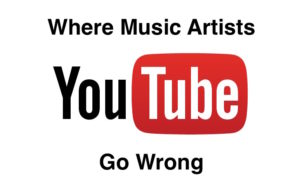Where Music Artists Go Wrong On YouTube
 YouTube is capable of making people stars, and while that happens to exceptional content creators, most of them are not music artists. One of the reasons that artists don’t fall into the YouTube star category is that their general mindset is still set in the past. Here are the 4 places were artists go wrong on YouTube, which leads to far less success on the platform than they’re capable of.
YouTube is capable of making people stars, and while that happens to exceptional content creators, most of them are not music artists. One of the reasons that artists don’t fall into the YouTube star category is that their general mindset is still set in the past. Here are the 4 places were artists go wrong on YouTube, which leads to far less success on the platform than they’re capable of.
- It’s not about the views. YouTube is actually not optimized for total views, contrary to popular belief. It’s all about , according to industry analyst Mark Mulligan. Most artists get most concerned about views, which takes their focus away from what really counts.
- Major YouTube stars constantly drip content. They’re constantly posting on a schedule that their subscribers know and trust. Music artists, on the other hand, post an average of 3 videos every 18 months. The big problem is that even if these videos rack up some big numbers, the advertising revenue is lower because there’s not much inventory on the channel so the income is far lower than possible.
- Releases are too far apart. Most artists are still on an album cycle, where they work on an album for months or years and only release singles (and therefore videos) when that album is complete. The world that we live in today has moved way past that. In order to keep an audience, constant engagement is essential and that means the release of more content in a more timely fashion, just like the native YouTube stars.
- The video doesn’t have to be slick. If there’s one thing that we know from watching YouTube stars with huge followings is that production quality isn’t anything to get hung up on. A quick backstage video on an iPhone or impromptu acoustic jam can be far more effective than that big expensive music video. Like anything else, it still has to be entertaining, but with a little thought, a cheap video can still be very effective.
Artists and bands have a love/hate relationship with YouTube but the fact of the matter is that it’s still one of the most effective ways of getting your music out to both fans and non-fans alike, and growing an audience. That said, the techniques that worked in the past are no longer valid. Luckily, there are some very good models to look at for guidance, but few of them are from the music business.

